Are Baby Snaping Turtles Suposed to Smell Alful
Babe Snapping Turtle Overview
The Snapping Turtle refers to a family of big freshwater turtles named for their method of biting. They are native to and found throughout Northward America, from Canada to the west coast of northern Due south America. Their natural range extends from Southern Alberta to Nova Scotia and the Rockies, extending south all the mode to the Gulf of Mexico and parts of Florida. They have likewise fabricated their domicile in pocket-sized pockets in Mexico, Key America, and Ecuador.
Snapping Turtles are known for their huge size and aggressiveness, especially when out of the water. They have strong beak-like jaws and spry neck. This is why the nigh widespread species, the Mutual Snapping Turtle, has the scientific name Chelydra serpentina, where serpentina ways "snake-similar". The Snapping Turtles are characterized by loftier bloodshed during their younger years, experience delayed sexual maturity, and live to a very long historic period in one case they've matured into adults. In this commodity, we will learn virtually Baby Snapping Turtles and the definitive guide to caring for them.
| Information Chart | Baby Snapping Turtle |
| Scientific Name: | Chelydra serpentina |
| Family: | Chelydridae |
| Care Level: | Difficult |
| Temperament: | Aggressive |
| Color: | Night brown, tan, or black |
| Lifespan: | 30-forty years |
| Size: | half-dozen-10 cm for hatchling20-fifty cm for an adult |
| Diet: | Omnivorous |
| Minimum Tank Size: | 10-xv gallons for hatchling, 150 gallons for adult |
| Temperature: | 78-lxxx °F (25-27 °C) |
| Water Conditions: | pH half-dozen.8-vii.2 with medium hardness |
| Tank Mate Compatibility | Should exist kept lone |

Babe Snapping Turtle Appearance
A Baby Common Snapping Turtle ordinarily has a plain or dark dark-brown upper shell, chosen the carapace, with mixed dark-brown or olive stains. The vanquish has iii long ridges running lengthwise which wear downward with time. Their belly shell, called the plastron, is very narrow and cross-shaped and leaves their extremities exposed. While their head is dark in color, Snapping Turtle Babies take yellowish necks, legs, and tails. The jagged tail is nearly as long as the shell. They take characteristic tubercles on their necks and webbed feet, precipitous claws, and a powerful, bony bill. Snapping Turtle hatchlings are near ii.5-4 inches and counterbalance just a few ounces, but can grow upward to 20 inches and 35 pounds as adults. Female Snapping Turtles are generally smaller than males.
Types of Baby Snapping Turtles
Chelydra serpentina
They are also called the Common Snapping Turtles and are the most common species. They are widespread in North America. They are 1 of the heaviest native freshwater turtles in the northern part of their range.
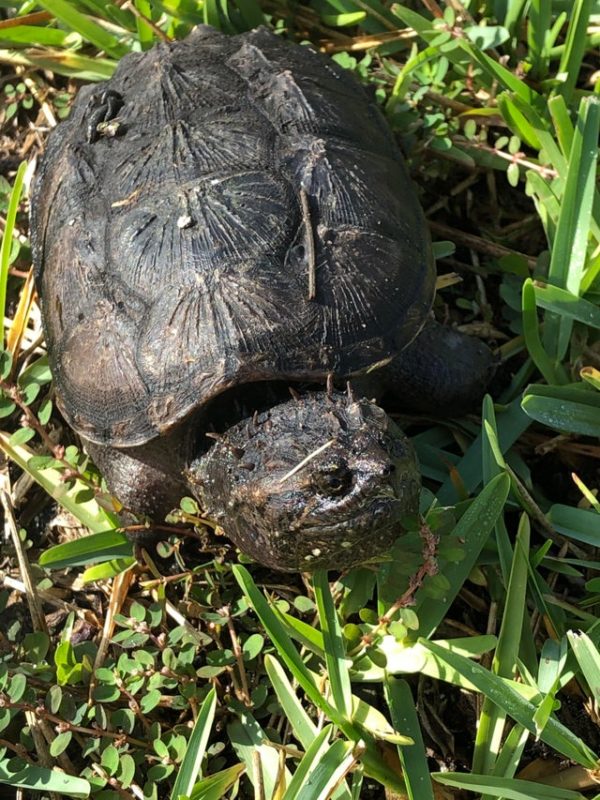
Chelydra rossignonii
They are also known every bit the Central American Snapping Turtles, the Mexican or the Yucatan Snapping Turtles. They are endemic to Central America and Mexico. Previously considered a subspecies of Chelydra serpentina, information technology became a full species afterwards some genetic differences and differences in the morphology of the skulls were noticed. Yucatan Snapping Turtles have a large head and a lengthy tail, with a dark-brown or olive coarse carapace and a creamy plastron.
Chelydra acutirostris
They are known commonly every bit the South American Snapping Turtles. They are owned to Primal and northwestern South America. They were also previously considered a subspecies of Chelydra serpentina. Southward American Snapping Turtles are generally smaller in size than the common Snapping Turtles, and are establish in Honduras, Nicaragua, Republic of costa rica, Panama, Republic of colombia, and Republic of ecuador.
Lifespan of Baby Snapping Turtles
The typical lifespan of a Babe Snapping Turtle is 30 to xl years in captivity.
This depends upon the quality of care, merely Snapping Turtles have been known to live up to 50 years in captivity, while in the wild their estimated maximum age is over 100 years.
Babe Snapping Turtle Size
The typical Snapping Turtle Baby will more often than not grow up to 8 to 20 inches.
Snapping Turtle Babies are about ii.five to 4 inches long, and measure 6 inches past the fourth dimension they are 5 years old. By the historic period of 12-15 years, Snapping Turtles achieve their maximum size betwixt 8 to 20 inches. Nevertheless, they continue growing slowly throughout their life. The average length of an adult Snapping Turtle is fifteen inches.
Natural Habitat and Origin
The Mutual Snapping Turtles, along with the other two species of Chelydra, are restricted to the Americas. They are native to the Northward American continent and are generally institute in southeastern Canada, along with parts of the Rocky Mountains, Nova Scotia, and Florida. Common Snapping Turtles can too be found in United mexican states, Central America, and a pocket-sized region of South America.
The natural habitats of Common Snapping Turtles are shallow freshwater ponds, marshes, or streams. They prefer to alive in swampy areas or rivers with silted beds. Common Snapping Turtles spend virtually of their time in the water and prefer to burrow nether a muddy cover with only their eyes and nostrils exposed for breathing. They like turbid water bodies and sluggish currents, with plenty of vegetation and rocks amidst which they can hibernate. These conditions might be replicated for Baby Snapping Turtles in artificial tanks.
Infant Snapping Turtle Care & Tank Fix-Up
Baby Snapping Turtle Tank Size and Specifications
Optimum Tank Size for Baby Snapping Turtles
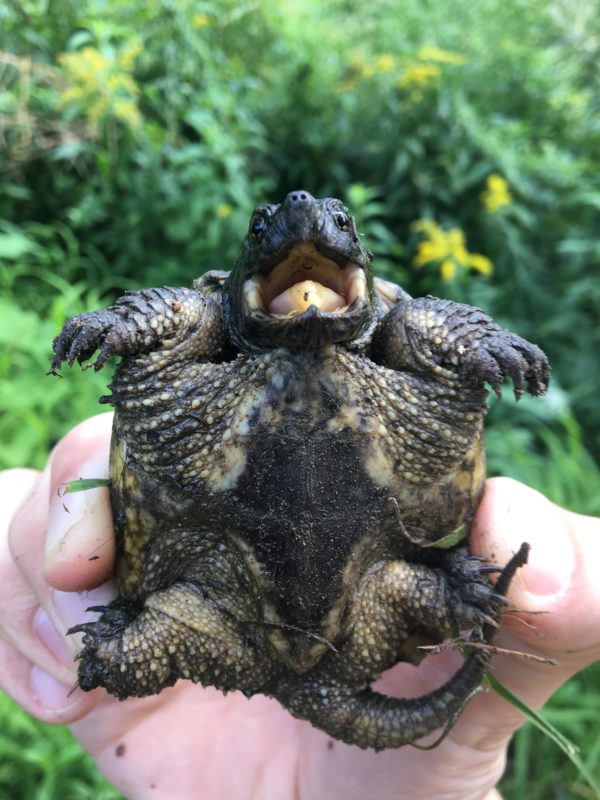
The recommended tank size for a Baby Snapping Turtle is about 3 square feet or 10 to 20 gallons.
However, Baby Snapping Turtles will soon outgrow this, and an adult Snapping Turtle needs a tank approximately threescore square feet or 150 gallons in size. The water needs to be deep enough so they tin swim, but shallow enough and then they tin can sit on the bottom and stretch their necks for breathing. A good approximation is making the water slightly deeper than the turtle'southward width.
Tank Blazon for Infant Snapping Turtles
Plastic fish ponds, swimming liners, and large tubs may exist used to house the Baby Snapping Turtle. Glass terrariums and even pocket-size children'due south pools are proficient enclosures. A pre-formed pond can likewise be considered, keeping in mind their growing potential. The top of the tank should be secured using a durable wire elevation to prevent the Infant Snapping Turtle from escaping. A dock should as well exist added to the tank to allow the turtle to savour while partially submerged in water.
Filter Blazon
Filtration is crucial for the health of Infant Snapping Turtles. As the Snapping Turtles eat a lot of nutrient, the tank water can get stale really quickly with leftover food particles and waste material. Thus a strong filtration system with biological, mechanical, and chemical filtration is required, peculiarly equally the Snapping Turtle grows older. In add-on to this, regular water changes every ii-four weeks are also important.
Substrate
While the Snapping Turtles tin live without substrate, they are generally less stressed and more relaxed when the tank weather mimic their natural habitat. Thus, a combination of plants and driftwood acts as an appropriate substrate for their needs. However the Snapping Turtle may swallow the live plants, and and then an culling substrate can be rocks and clay pots. This is to provide the Snapping Turtle Baby with enough of ideal hiding spots. Rocks should be big plenty to not exist swallowed accidentally and can exist glued together with a non-toxic aquarium sealant as well for added protection.
How many Baby Snapping Turtles should be kept in 150 gallons?
The dominion to follow is ten gallons of water for every 1 inch of the turtle shell. A minimum of 10 to xx gallons is required for a Snapping Turtle hatchling, while this may become upwardly to 150 to 200 gallons as the turtle grows in size. Further, the Snapping Turtles can be quite ambitious to each other, so it is recommended to just shop a turtle solitary in a tank.
Water Parameters for Infant Snapping Turtles
H2o Temperature
The platonic water temperature for Baby Snapping Turtles is 78 to 80 °F or 25 to 27 °C.
While Common Snapping Turtles tin withstand colder temperatures in the winters, this is the optimum temperature range that should be maintained for hatchlings. For adults, the optimum range for healthy development is 75 to 78 °F or 23 to 26 °C. The temperature for the basking dock should not exceed 90 to 95 °F or 32 to 35 °C. These temperatures tin can be obtained using underwater heaters in the tank. The temperature can exist monitored using thermometers or a digital thermostat to prevent information technology from going out of range. Also, the ambient air temperature to a higher place the tank should be fourscore to 86 °F or 26 to 30 °C. This can be possible via a ceramic heater or a thermostat. These temperatures help the Baby Common Snapping Turtles stay healthy and prevent stress.
pH Level
The perfect water pH level for Baby Snapping Turtles is pH 6.8-seven.2.
This prevents the water from becoming too acidic or too basic for the Infant Snapping Turtles. If you want, a small-scale amount of aquarium salt can be added to make the water a little brackish.
Water Hardness
The h2o should also not be overly hard or soft. Thus a moderate corporeality of hardness should be maintained. Information technology is also of import to use treated, chlorine-free water to proceed the Infant Snapping Turtles healthy.
Infant Snapping Turtle Tank Landscape
Infant Snapping Turtles tin abound to huge sizes and their tank should be prepare upwardly to adapt that. Their natural habitat should ideally be recreated in their tank. It should have an appropriate corporeality of clutter for the Baby Snapping Turtles to feel safety when trying to hibernate. Since Infant Snapping Turtles like to bask, a defended basking dock with proper lighting atmospheric condition is also required. As Snapping Turtles don't like to leave the water, a sloping dock that allows them to remain partially submerged is ideal.
Best and Worst Plants for Infant Snapping Turtle Tanks
Snapping Turtles require a lot of free space to swim around. In addition to that, they are more than than probable to consume live plants placed in the tank. For this reason, plants may be more often than not skipped if you lot're planning to look after some Infant Snapping Turtles. However, sometimes plants may also provide hiding spots for the turtles in captivity. So if desired, information technology's best to keep the number of plants to a minimum. For this purpose, plants similar Anacharis, Hornworts, or Coffee Ferns may be used.
Decorations for Babe Snapping Turtle Tanks
Since live aquatic plants may pose a feeding trouble for the Babe Snapping Turtles, you tin can instead opt for decorative plants. Decoration should be chosen based on whether it provides aplenty hiding space to the Baby Snapping Turtles without hampering their motion, as the turtles can be destructive to elaborate decorations. To this finish, items like clay pots, submergible storage boxes, and driftwood can be utilized.
Lighting for Baby Snapping Turtle Tanks

Specific lighting arrangements are needed to help the Snapping Turtles bask easily and to prevent diseases. A loftier-quality infrared basking light should be placed over the unabridged tank for this purpose. Simply Infant Snapping Turtles as well require total-spectrum UVB lighting over their basking spot to maintain their shells, as information technology helps them blot calcium improve. The UVB calorie-free tin can as well help mimic natural 12-hour cycles in captivity and stimulate Vitamin D production in the Baby Snapping Turtles. It is skilful practise to place the UVB lamp within twelve inches of the Babe Snapping Turtle's shell while it basks. The UVB lamp picked for this purpose should conspicuously mention 10% UVB to keep the radiation within safety limits, and it should be replaced every 6-12 months to maintain optimum light output.
Feeding Infant Snapping Turtles
Best Diet for Baby Snapping Turtles
In the wild, Snapping Turtles are omnivorous and will feed on almost annihilation they can catch in their beaks. Thus their diet should consist of both animal and plant matter, and they can be fed live as well as artificial foods for the same. To maintain water quality and prevent overeating, a good exercise is to give the Snapping Turtles merely enough food which they tin terminate in ten to fifteen minutes.
Snapping Turtle Hatchlings require a protein-rich diet. This tin can contain redworms and bloodworms, small unfrozen fish pieces, small fishes, shrimps, and other meaty products. All food should exist cut into small pieces. Snapping Turtle Hatchlings can likewise be given sliced fruits equally an occasional snack. An Adult Common Snapping Turtle'southward diet should be similar to Baby Snapping Turtles but should contain 1-quarter of plant affair too. This can come from duckweeds, h2o hyacinths and h2o lettuce, and premade leafy foods. Common Snapping Turtles tin also feed on any healthy and fresh plants growing inside their tank, and tin occasionally be treated to pears, apples, carrots, grapes, and strawberries or blackberries.
In terms of artificial foods, Snapping Turtles tin be fed commercial turtle pellets which are rich in nutrients otherwise not obtained through natural nutrient. Alternatively, their food can be dusted with multivitamin and calcium supplements. Snapping Turtles tin can also be fed turtle-appropriate granules and flakes for a quick snack. Pre-killed rodents are also good for Snapping Turtles because of their highly calcified bones, and their fur tin can assistance with the passage of other nutrient through the turtle's arrangement as well.
How ofttimes should you lot feed Baby Snapping Turtles?
Snapping Turtle Babies under 6 months old should be fed twice daily.
While Snapping Turtle Babies will eat significantly less than developed Snapping Turtles, the feeding frequency for them is higher. After that, until they are ii years onetime, they should be fed once a day. Once Infant Snapping Turtles cross 2 years of historic period, they should only be fed twice or thrice a week. More often than not, if Baby Snapping Turtles start jutting out of their trounce their diet should exist restricted, and if their skin begins to sag their diet should be improved.
Babe Snapping Turtle Behavior and Temperament
Are Baby Snapping Turtles lonely or societal in nature?
In the wild, Mutual Snapping Turtles are solitary in nature. Social interaction amidst the species is rare and ordinarily only includes in-fighting betwixt males. For this reason, cohabitation should be prevented. Infant Mutual Snapping Turtles are generally calm and docile within water and like to burrow or hide in a predatory manner. However, they are extremely aggressive when removed from the water and should be handled with keen care, since they are likely to hiss and snap at anything they perceive as a threat.
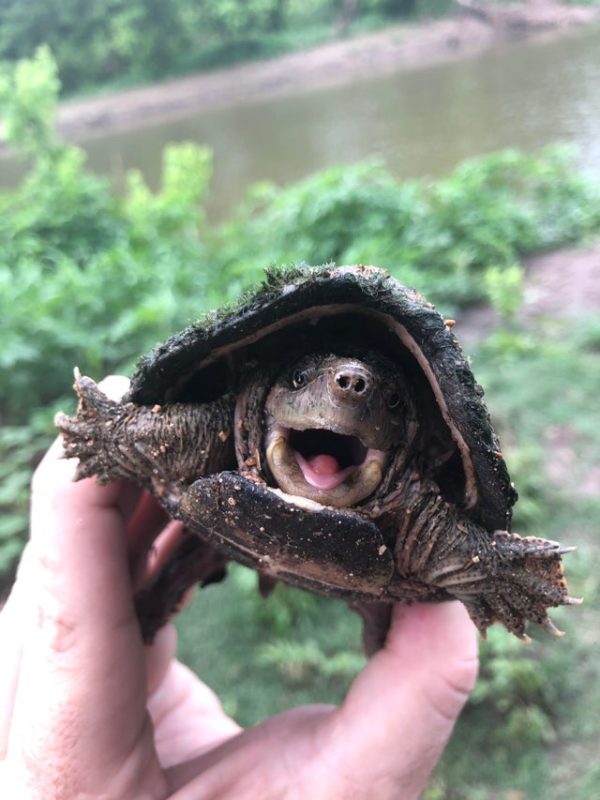
Baby Snapping Turtle Tank Mates
Ideal and Bad Babe Snapping Turtle Tank Mates
Since Snapping Turtles are at the peak of the food concatenation in their natural environment, most everything is prey for them. This includes fishes, reptiles, and even other turtles! This is why it is recommended to go on Babe Snapping Turtles in a solitary surround. Only in case you lot really do have to give them tank mates, slow and sluggish fishes should exist out of consideration. This includes goldfish, sunfish, or koi fish. Similarly, bottom feeders should as well be skipped as they might cross paths with the Baby Snapping Turtle. This includes plecos, catfish, and even shrimps, crayfish, and freshwater aquarium snails. Thus, if you practice end up making the Baby Snapping Turtles share space, choose small and fast freshwater fishes, like guppies or neon tetras, or zebrafish. However, it should be kept in mind that sooner or later they might all endure the same fate at the hands of the turtle.
Breeding Infant Snapping Turtles
The sexual maturity of Babe Common Snapping Turtles is directly related to their size. They are set to mate when their upper shells are approximately half dozen inches long. Male Snapping Turtles accomplish this size at around 5 years of historic period, while females reach reproductive maturity between iv to 7 years. Their mating flavour lasts from April to Nov, but they are more than active during the warmer months, typically between April and May. During courtship, the male and the female Snapping Turtles confront each other and motility their forepart legs and heads from side to side. The mating procedure begins when the male Snapping Turtle mounts the female Snapping Turtle and adjusts his tail, to bring the cloacal openings into contact. The mating process might be a little aggressive, with both the male and the female biting each other during it, but these are temporary scars that heal speedily.
The female Snapping Turtle will usually lay her eggs in early on summertime, between late May and June. However, depending on when they mate this can extend into autumn. The number of eggs a female person Snapping Turtle will lay in a batch depends upon her size. On average, a clutch contains nigh 20 to 40 soft-shelled, foam-colored eggs the size of table lawn tennis balls. Some nests have been known to contain virtually 100 eggs at the same time.
The female person Snapping Turtle will more often than not lay her eggs by excavation a 4 to 7-inch deep nest in loose soil, sand, loam, piles of sawdust, rotten vegetation debris, or a similar substrate for incubation and protection. The incubation catamenia tin be anywhere between 8 to 18 weeks, and averages effectually 93 days before a hatchling emerges from the egg, usually between August and Oct. However, sometimes the Snapping Turtle hatchling tin can overwinter in the nest and enter its first hibernation, not emerging until the next spring, depending on the climate of the location.
The Snapping Turtle Hatchlings are only around an inch long when they emerge from the eggs. The sex determination of the hatchlings is temperature-dependent. Eggs maintained at a cooler temperature (around 75 to 78 °F to or 24 to 26 °C) predominantly hatch male Baby Snapping Turtles, while at higher temperatures (more than 84 °F or 29 °C) the offspring is by and large female person.
Infant Snapping Turtle Breeding Level – Intermediate
Baby Snapping Turtle Sexual Dimorphism
Male and female Baby Snapping Turtles are most accurately distinguished by the divergence in their pre-cloacal tail length; the distance from the posterior cease of the plastron to the cloaca is greater in males than it is in females.
There are plenty of visual differences between male and female Baby Snapping Turtles, which makes them sexually dimorphic.
Adult male Snapping Turtles typically have thicker, longer tails and their vents are farther downwardly the tail. On the other hand, female person Snapping Turtles tend to take shorter tails and their vents are closer to their body. Also, the plastron in males is smaller and the bridges connecting the plastron and carapace are narrower, which helps them concord on to the females during copulation. Female Snapping Turtles also tend to be smaller, only this is not always reliable.
Baby Snapping Turtle Common Diseases and their Treatment
Trounce Rot
Parts of the bone of the shell of Baby Snappers may deteriorate, often leaving the underlying scutes intact. This is due to the poor quality of water or chemical imbalances in it. The Snapping Turtle should be removed from the tank and the damaged soft part of the shell should be removed before the surrounding surface area is cleaned and dried. The Snapper should be soaked for virtually an hour in a sulfa bath and dried earlier being returned to the h2o. This should exist repeated daily for a calendar week. In astute cases, topical antibiotics such every bit silverish sulfadiazine foam can be applied daily to the shells as well. Shell rot can be prevented by cleaning the tank h2o regularly and maintaining the pH of the water.
Fungus Infection
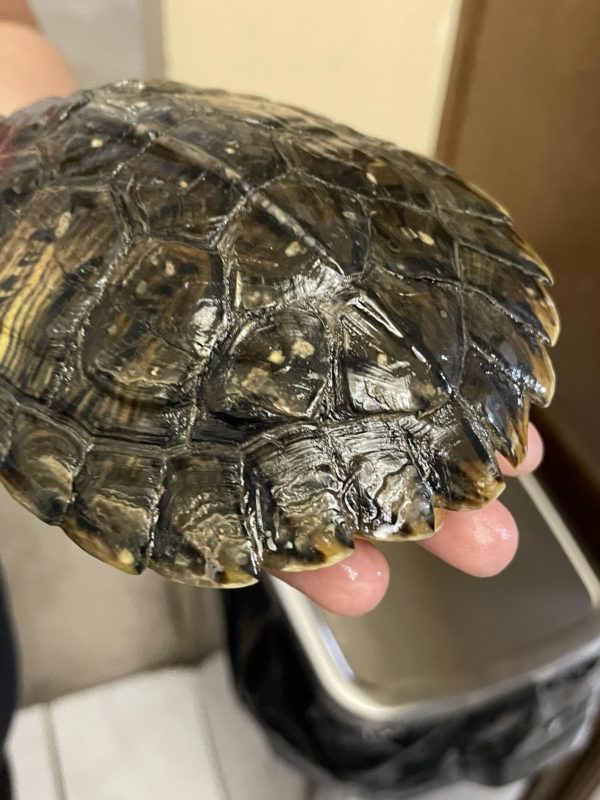
White blotches on the Snapping Turtle Babe's skin may appear, signifying fungal infection acquired either due to dirty water or bereft basking. The treatment is exactly similar to that for beat out rot. Sometimes the scars may remain even later on the skin has regenerated. Infection can be prevented by using a proper filtration system and removing waste regularly.
Hypovitaminosis
Hypovitaminosis refers to a lack of vitamins. Vitamin D3 deficiency can cause a deformed, hunched-back trounce in Snappers. It is commonly due to a lack of proper exposure to sunlight or substituted artificial lighting. Vitamin A deficiency symptoms include swollen eyes, a runny nose, a raspy breathing voice, and aberrant peeling of the skin. Vitamin B12 deficiency is characterized by paralysis or numbness of the turtle's legs. Hypovitaminosis can exist treated by improving diet and giving commercial vitamin and mineral supplements to the turtle regularly. Vitamin D deficiency can likewise be treated by exposing turtles to direct sunlight for at least an hr daily, or alternatively past providing full-spectrum UVB basking light.
Parasites
External parasites like ticks are piece of cake to spot as they are attached to the Infant Snapping Turtle'due south skin. Internal parasites are harder to detect; however, they are mostly harmless, unless the Snapping Turtle Hatchling is passing visible parasites. Both these conditions are likely due to dirty h2o in the tank and irregular cleaning. External parasites should be treated with methylated alcohol and softly removed one time their grip loosens. In the instance of internal parasites, the Snapping Turtle should exist soaked in water containing piperazine daily for a few weeks. Commercial dewormers for turtles may also be used. To preclude parasites, the h2o should be cleaned and filtered regularly, and the enclosure should be covered with a wire mesh.
Proteus infection
If the Babe Common Snapping Turtle has trouble sinking in water, floats at an odd angle, or has swollen feet, it might be suffering from a Proteus infection. This is a serious condition and can exist fatal if left untreated. The turtle should exist taken to a doctor and provided professional treatment immediately.
Facts about Baby Snapping Turtles
- Common Snapping Turtles accept an average bite force of 200 Newtons, but have been known to exert much college forces in the wild – upward to 600 Newtons!
- The Common Snapping Turtle was chosen as New York's official State Reptile in 2006
- Unlike other turtles, Common Snapping Turtles cannot retract their whole body into their shell and must rely on their powerful beaks to protect themselves
- Snappers are normally quiet and docile during the twenty-four hour period since they are nocturnal hunters by nature
- When they feel stressed, Babe Snapping Turtles can release a musky odor from behind their legs
- Common Snapping Turtles are remarkably tolerant to cold atmospheric condition, and some tin even remain active under the ice
- Mutual Snapping Turtles are currently classified nether 'To the lowest degree Concern' by the IUCN
Are Baby Snapping Turtles Right for You?
Caring for Babe Common Snapping Turtles is moderately difficult due to their large size, mostly aquatic nature, and aggressive behavior. Due to their strong, powerful beaks and long, agile necks, they require specialized handling out of water. As well, since they prey on almost everything, they aren't suitable for yous if you plan to go along a lot of other fishes and aquatic animals in the aforementioned aquarium. However, Baby Snapping Turtles are also extremely interesting and entertaining, and due to their long lifespans of 30 to 40 years, can prove to be great companions if given due attention and proper facilities. They aren't picky eaters and tin can thrive under a adept filtration system and regular cleaning and check-ups. Thus if you have ample infinite to firm them and can commit to them long-time, Snapping Turtle Babies are sure to be one of the most fun pets to have!
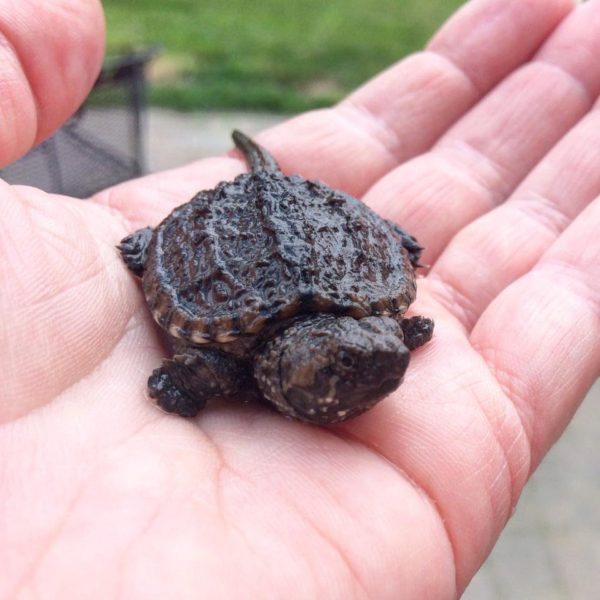
FAQ
Exercise Infant Snapping Turtles need a oestrus lamp?
Fluorescent bulbs are needed for your Snapping Turtle Hatchlings if their tank is not in a location that receives direct sunlight. Bulbs that contain UVB are the best substitutes and allow the Snappers to relish. A heating lamp tin can too be used to maintain the tank's temperature according to the turtle's age – around 80 °F or 27 °C – if yous live in a cold region.
Tin Snapping Turtles drown?
Equally aquatic equally Snappers appear, they cannot exhale underwater. Common Snapping Turtles tin tire out and drown if they are forced to repeatedly swim to the surface to breathe. Thus, the water depth in a tank should let the Snapping Turtle to sit on the bottom and achieve its caput to the surface to exhale comfortably. If you believe your Snapping Turtle has drowned, do non turn it upside downwardly, and take it to a reptile vet as quickly every bit possible.
Practise Snapping Turtles eat other turtles?
Snapping Turtles will eat almost annihilation that they can catch, and so some. Snapping Turtles have been known to impale other turtles, sometimes even of their ain species, by biting off their heads. This behavior is commonly territorial since Mutual Snapping Turtles are lonely and do not similar company.
Do Baby Snapping Turtles bite?
Infant Snapping Turtles are aggressive by nature and can bite sharply. The common species' average bite strength is 209 Newtons. Every bit adults, their powerful jaws tin can even remove a finger or ii, although recorded cases of this happening are very rare. However, Snappers should always be handled with care and should exist picked only by grabbing the carapace above the hind legs to prevent injury to both yourself as well as the turtle.
Determination
Babe Mutual Snapping Turtles are very interesting to learn virtually and can prove to exist dandy life-long pets when handled with care. As long every bit you can keep up with their growing size and give them a proper enclosure, food, and regular medical attention, you can definitely form a positive human relationship with Baby Snapping Turtles and have a lot of fun.
Source: https://theaquariumguide.com/articles/baby-snapping-turtle
0 Response to "Are Baby Snaping Turtles Suposed to Smell Alful"
Enregistrer un commentaire